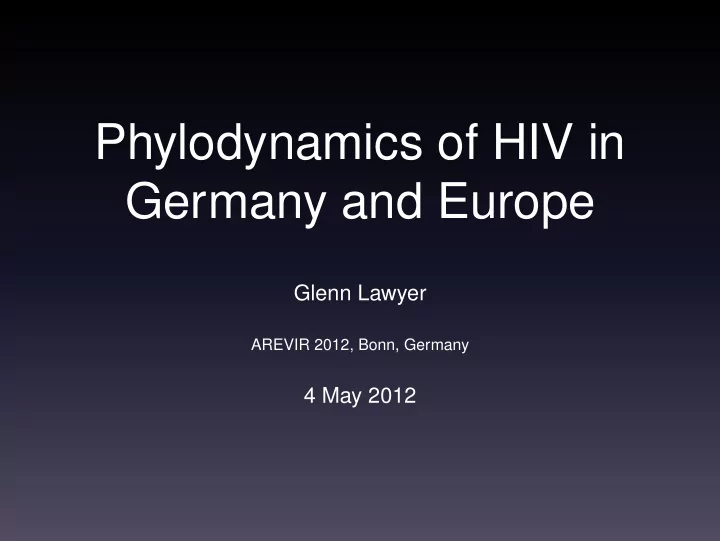

Phylodynamics of HIV in Germany and Europe Glenn Lawyer AREVIR 2012, Bonn, Germany 4 May 2012
Continuing HIV transmission in Europe • 27,116 newly diagnosed cases in 28 EU/EEA countries • 18% increase in newly diagnosed cases (7.8 per 100K), but stable in HIV/AIDS surveillance in Europe EU (5.7 per 100K). ECDC 2010 report • Predominant mode of transmission is MSM. What is the structure of • Predominant mode the transmission varies by area. networks?
Continuing HIV transmission in Europe • 27,116 newly diagnosed cases in 28 EU/EEA countries • 18% increase in newly diagnosed cases (7.8 per 100K), but stable in HIV/AIDS surveillance in Europe EU (5.7 per 100K). ECDC 2010 report • Predominant mode of transmission is MSM. What is the structure of • Predominant mode the transmission varies by area. networks?
Phylodynamics Limitations Fundamental insight • Influenced by Viral evolution and sampling epidemic spread occur on • Cannot determine the same timescale direction of transmission Routine clinical • Sequences not taken diagnostics allow us to at time of track the epidemic seroconversion
What is the pattern of new infections? Network(s) structure • cluster size distribution • bounded or growing? • loose or dense coupling? Crossover transmission • regions • transmission groups
Previous Work – 1 UK: Two research groups , three studies A dated phylogeny approach has revealed the HIV epidemic among MSM in London to have been episodic . . . ECDC 2010 report UK has high rate of newly reported infections (10.7 per 100K)
Previous Work – 1 UK: Two research groups , three studies A dated phylogeny approach has revealed the HIV epidemic among MSM in London to have been episodic . . . ECDC 2010 report UK has high rate of newly reported infections (10.7 per 100K)
Previous Work – 2 ARCA Study (Italy) 11,541 subtype B patients • over 2/3rds of sequences cluster • median cluster size 4 • two large clusters ( > 1000 members) Prosperi, MCF et al. A novel methodology for large-scale phylogeny partition. Nat. Commun. 2:321 doi: 10.1038/ncomms1325 (2011).
RESINA Study Cohort count percent count percent MSM 1396 51% B 1962 71% Endemic 382 14% A 302 11% Hetero 494 18% CRF 234 9% IVDA 184 7% C 94 3% Bisexual 40 1% D 48 2% Blood 16 – G 57 2% Unknown 235 9% urf 35 1% TOTAL 2747 100% TOTAL 2747 100%
Determining clusters Network construction Pairwise base-pair difference Link similar sequences Range of values Network characteristics as similarity cutoff moves from 35-40 bpd (96.8% sequence similarity)
Petridish plot
By the numbers Group n clustered small clusters MSM 1396 53-63% 35-27% Hetero 493 47-56% 33-31% Endemic 382 34-42% 30-34% IVDA 184 54-62% 25-17% Bisexual 40 50-62% 32-30% Unknown 252 53-60% 38-31% TOTAL 2747 49-58% 34-29%
The large networks
A closer look
Large cluster growth Linear growth implies rate of transmission is slowing Consistent with ECDC 2010 report, Prosperi et al.
EuResist Italy Germany Sweden Portugal Other MSM 951 1438 628 91 1625 IVDA 1830 159 178 146 934 HET 1759 418 286 137 2452 TOTAL 4540 2015 1092 374 5011
EuResist Italy Germany Sweden Portugal Other MSM 951 1438 628 91 1625 IVDA 1830 159 178 146 934 HET 1759 418 286 137 2452 TOTAL 4540 2015 1092 374 5011
EuResist Clustering in EuResist patients Italy Germany Sweden Portugal MSM 30% (951) 43% (1438) 66% (628) 30% (91) IVDA 26% (1830) 55% (159) 70% (178) 63% (146) HET 22% (1759) 21% (418) 39% (286) 46% (137)
Country-level assortitivity Assortitivity coefficient err − er 2 � AC = � � r r – data type err – fraction of edges between two members of r er 2 – fraction of all edges from type r Assortitivity coefficient at varying thresholds for the three main transmission groups
MSM petridish plot Little cross-border transmission • Italy, Germany– many small clusters • Sweden– One large cluster, several small
MSM phylogenetic tree What can we say about branch length? Clustering? Supports findings from distance-based methods Phylogenetic tree of MSM cluster
Hetero petridish plot Little cross-border transmission • Portugal – localized • Italy/Sweden – threshold issue? • Sweden/Other – mixing
IVDU petridish plot Little cross-border transmission • Portugal – two clusters • Italy/Sweden – One large, several medium clusters
THANKS RESINA Study Group EuResist Project
Recommend
More recommend